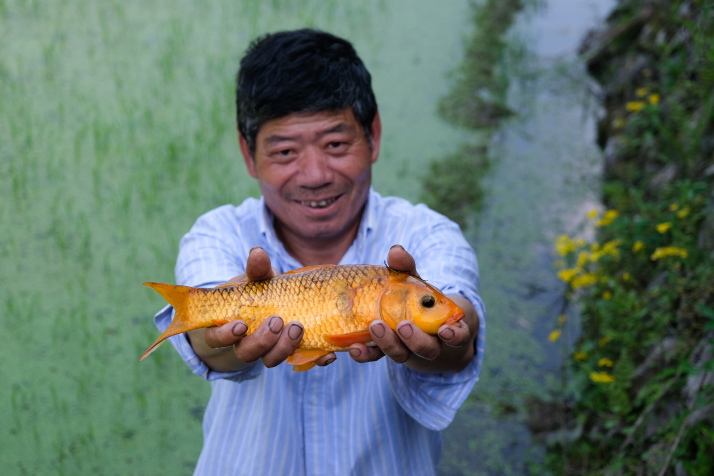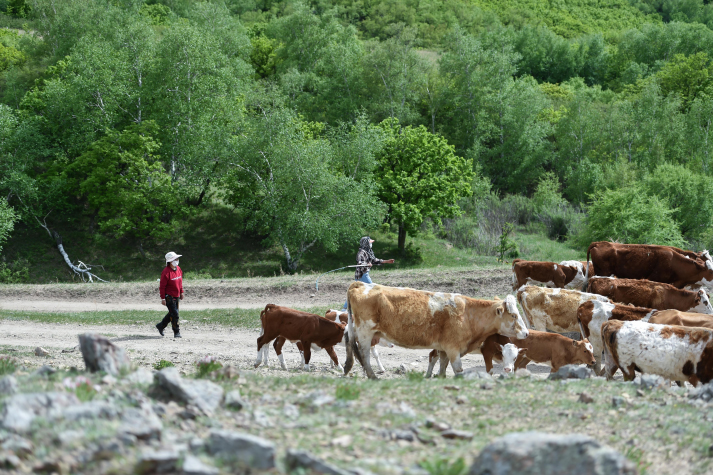
As early as more than 1,200 years ago, farmers in Qingtian, a county in Zhejiang Province, began to raise fish in their paddy fields, forming a rice-fish agricultural system. In this system, the rice provides shelter and organic food for the fish while the fish can soften the soil, provide fertilizer, and eat pests and weeds. The system helps maintain the ecological balance of the fields, and facilitates a dual harvest of rice and fish.
A unique culture has grown out of the rice-fish system. For instance, these paddy field fish are used as dowries for local marriages, and the fish lantern dance, in which people dance with fish-shaped lanterns in hand, has become an important part of festival celebrations and is recognized as a form of national intangible cultural heritage.
In 2005, the rice-fish culture in Qingtian was listed in the world's first group of Globally Important Agricultural Heritage Systems (GIAHS) by the Food and Agriculture Organization (FAO) of the United Nations, making it the first of China on the list. This year, which marks the 20th anniversary of the GIAHS program, the World Conference on GIAHS was held in Qingtian from July 17 to 19.
Strengthening protection
According to the FAO, the GIAHS are agroecosystems inhabited by communities that live in an intricate relationship with their territory. These evolving sites are resilient systems characterized by remarkable agrobiodiversity, traditional knowledge, invaluable cultures and landscapes, sustainably managed by farmers, herders, fisherfolk and forest people in ways that contribute to their livelihoods and food security.
Co-hosted by China's Ministry of Agriculture and Rural Affairs (MARA) and the government of Zhejiang Province, the conference was attended online or onsite by agriculture ministers from 15 countries, 19 countries' ambassadors to China and representatives from international organizations such as UNESCO. It was themed Agricultural Heritage for Rural Prosperity.
In Chinese President Xi Jinping's congratulatory letter sent to the conference, he said that protecting agricultural heritage is the shared responsibility of humanity, which has created splendid farming civilizations in its long history.
China is willing to work with the international community to strengthen the protection of agricultural heritage systems, further tap their economic, social, cultural, ecological, scientific and technological value, help implement the UN 2030 Agenda for Sustainable Development, and promote the building of a community with a shared future for humanity, Xi said.
When speaking at the conference, Tang Renjian, China's minister of agriculture and rural affairs, called for united action from countries around the world to strengthen agricultural heritage protection.
To improve capacity building, Tang said that China and the FAO will jointly launch a $3-million program to provide training to 1,000 managers in the field of agricultural heritage protection.
Marcos Montes Cordeiro, Brazil's minister of agriculture, livestock and food supply, hailed the positive role of the initiative over the past two decades, saying that it has played an important role in advancing the sustainable development of agriculture, and also made contributions to improving people's lives and promoting rural prosperity.
To date, 18 sites in China have been added to the FAO's GIAHS list. The network now consists of 65 systems in 22 countries around the world, with China being the largest single contributor to the list.

A success story
Min Qingwen, a member of the GIAHS Expert Committee of MARA, visited Qingtian after the county's recognition as a GIAHS site. He recalled that at that time local farmers weren't able to understand the value of the rice-fish system. They only knew that they had kept fish in paddy fields for generations and the fish was tasty.
"We explained to them the significance of the system so that they could build cultural awareness and confidence, and realize the system is a treasure," Min told Shanghai Observer, a Shanghai-based news app.
The recognition has brought about tangible benefits for local people, with many starting businesses related to the rice-fish culture. For instance, Yang Xiaoai, a local who returned from Ecuador, has opened an agricultural heritage base for middle and primary school students to experience the culture. Another local Jin Yuepin who returned from France, developed large-scale rice-fish farming, helping more than 80 farmers increase their incomes.
The price of the rice has also increased from 4-6 yuan ($0.59-0.89) per kg to more than 20 yuan ($2.96) per kg.
Zhejiang is among the first provinces to carry out agricultural heritage protection in China. It now has 14 nationally important agricultural heritage systems, of which three are on the GIAHS list, the most in the country.
To better preserve agricultural heritage, the province is carrying out a census of its agricultural heritage.
According to the provincial department of agriculture and rural affairs, Zhejiang aims to be the first in the country to come up with a catalog of important agricultural heritage systems to lay a foundation for their protection.
The province has also stepped up the development of specialty agricultural industries and agricultural product branding. For instance, Huangyan District in Taizhou, where the tangerine planting technique was listed as a nationally important agricultural heritage system in 2020, has taken advantage of its long history of tangerine planting to promote its products. Huangyan was one of the first places in the world to grow the fruit and is a center for high-quality tangerines in China. There are records of Huangyan's tangerines in historical documents dating back to the third century A.D. and the fruit served as a tribute to the royal families in the Tang Dynasty (618-907). The district has used the slogan "hometown of the Chinese tangerine" to promote its fruit and attracted many customers nationwide. Huang Xibin, an official with the district's bureau of agriculture and rural affairs, said local tangerines can sell for as much as 60 yuan ($8.9) per kg.
Zhejiang has also upgraded the industrial chain. Deqing, a county in Huzhou, has made efforts to develop its freshwater pearl cultivation and processing after the system was listed as a nationally important agricultural heritage system.
Zhang Guanting, a staff member with the county's agriculture and rural affairs bureau, told China News Service that the county is the largest processor of freshwater pearls in China. Last year, the county processed nearly 100 tons of pearls, accounting for 10 percent of the national total output and achieving an output value of more than 7 billion yuan ($1 billion).
(Print Edition Title: Heritage for Rural Prosperity)
Copyedited by G.P. Wilson
Comments to jijing@cicgamericas.com